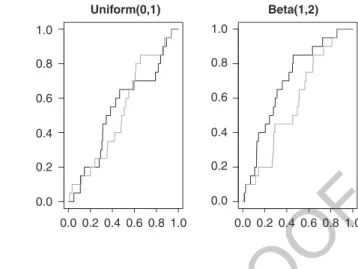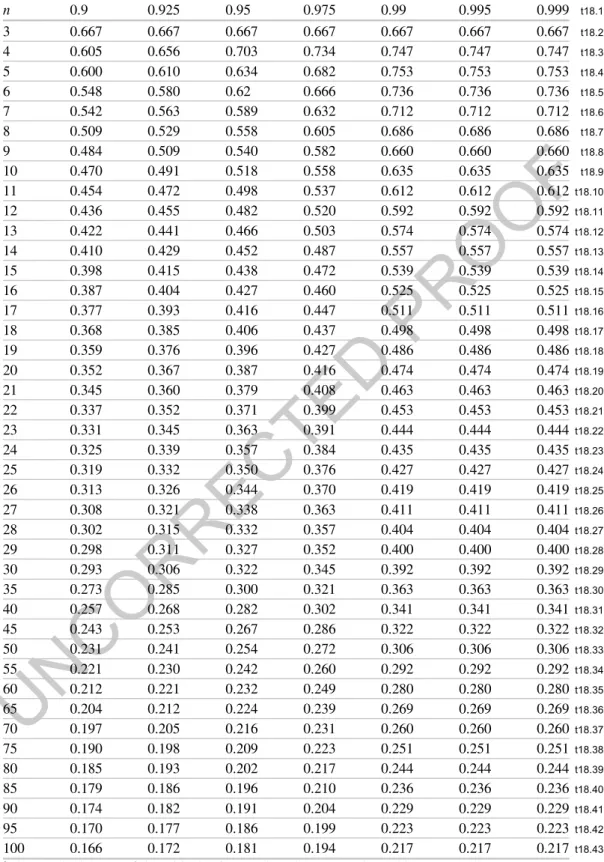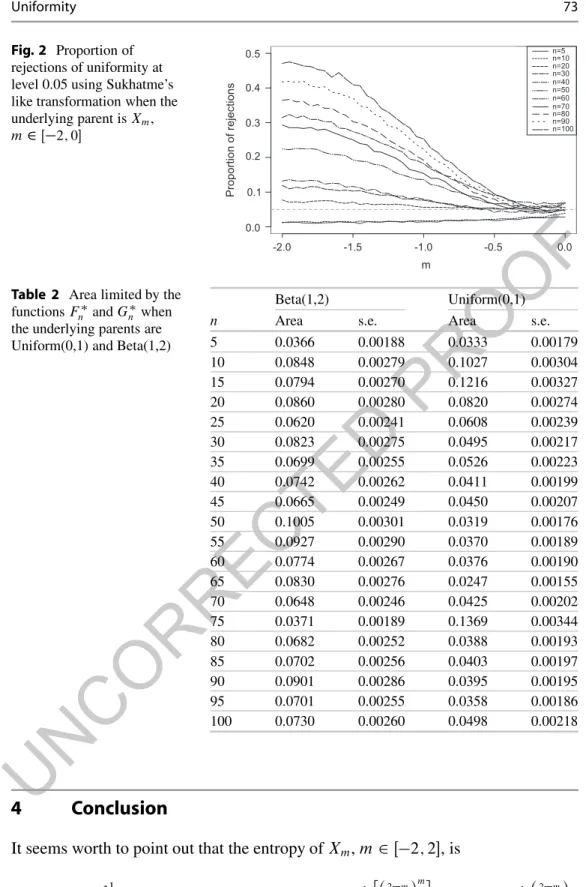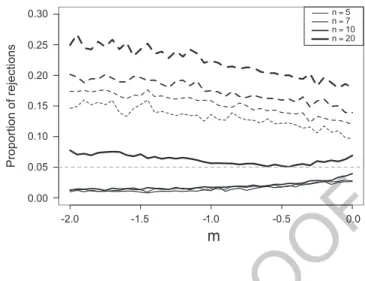UNCORRECTED
PROOF
Uniformity
2M.F. Brilhante, M. Malva, S. Mendonc¸a, D. Pestana, F. Sequeira,
3and S. Velosa
41
Introduction
5Let us assume that the p-values fpkgnkD1 are known from testing H0k vs. HAk, 6
k D 1; : : : ; n, in n independent studies on some common issue, and our aim is 7
to achieve a decision on the overall question H0! W all the H0k are true vs: HA! W 8
some of the HAk are true. As there are many different ways in which H0! can be 9
false, selecting an appropriate test is in general unfeasible. On the other hand, 10
combining the available pk’s so that T .p1; : : : ; pn/ is the observed value of a 11
random variable whose sampling distribution under H0! is known is a simple 12
issue, since under H!
0, p D .p1; : : : ; pn/is the observed value of a random sample 13
P D .P1; : : : Pn/ from a standard uniform population. In fact, several different 14
sensible combined testing procedures are often used [6, 11]. 15
M.F. Brilhante (!) AQ1
Universidade dos Ac¸ores (DM) and CEAUL, Rua da M˜ae de Deus, Apartado 1422, 9501-801 Ponta Delgada, Portugal
e-mail: fbrilhante@uac.pt M. Malva
Escola Superior de Tecnologia de Viseu and CEAUL, Campus Polit´ecnico de Viseu de Repeses, 3504-510 Viseu, Portugal
e-mail: malva@estv.ipv.pt S. Mendonc¸a" S. Velosa
Universidade da Madeira (DME) and CEAUL, Campus Universit´ario da Penteada, 9000-390 Funchal, Portugal
e-mail: smfm@uma.pt; sfilipe@uma.pt D. Pestana" F. Sequeira
Universidade de Lisboa, Faculdade de Ciˆencias (DEIO) and CEAUL, Bloco C6, Piso 4, Campo Grande, 1749-016 Lisboa, Portugal
e-mail: dinis.pestana@fc.ul.pt; fjsequeira@fc.ul.pt
J.L. da Silva et al. (eds.), Advances in Regression, Survival Analysis, Extreme Values,
Markov Processes and Other Statistical Applications, Studies in Theoretical and Applied Statistics, DOI 10.1007/978-3-642-34904-1 7,
© Springer-Verlag Berlin Heidelberg 2013
UNCORRECTED
PROOF
Therefore an important issue is to test whether a given sequence fpkgnkD1is or is 16not a sample from a standard uniform population. Recently Paul [10] discussed new
AQ2 17
characterizations of the uniform population, but as they are formulated in terms of 18
expected values, they did not lead directly to new simple tests of uniformity. Gomes 19
et al. [5] exploited the possibility of using computationally augmented samples 20
to test uniformity, with the surprising result that power can decrease with sample 21
augmentation in the class of alternatives they used. Sequeira [12] explains why this 22
is so, and in Sect. 2 below we further discuss the question. In this chapter we use 23
Sukhatme’s transformation to suggest new ways of dealing with the matter. 24
Sukhatme’s [13] transformation, from which R´enyi’s representation of expo- 25
nential order statistics can easily be derived, appears in David and Nagaraja ([2], 26
p. 17–18) and in Johnson et al. ([8], p. 305), with slightly different presentations, 27
applied to the study of exponential and of uniform order statistics, respectively. 28
Durbin [4] used ordered spacings of the uniform to investigate the construction of 29
exact tests. In Sect. 3 we use a Sukhatme’s like transformation to augment the set 30
of order statistics from a uniform parent, and in Sect. 4 we investigate power issues 31
when they are used in testing uniformity. 32
2
Uniformity Versus Mixtures of Uniform and Beta(1,2)
33Gomes et al. [5] introduced the family fXmgm2Œ#2;2! of absolutely continuous 34
random variables, with probability density function fXm.x/D
!
mx! m#22 "I.0;1/.x/ 35
(the uniform density corresponds to m D 0; for m 2 .0; 2!, Xm is a 36
convex mixture of Beta(1,1) and Beta(2,1), and for m 2 Œ!2; 0!, Xm is 37
a mixture of Beta(1,1) and Beta(1,2)). Observe that for all m 2 Œ!2; 0/, 38
P ŒXm" x! ! P ŒU " x! D m2 x .x! 1/ > 0 for all x 2 .0; 1/, and thus pseudoran- 39
dom numbers generated by Xmtend to be closer to 0 than pseudorandom numbers 40
generated by a standard uniform random variable U . Thus this family can give 41
important hints on nonuniformity of the set of p-values, cf. the concepts of random 42
p-values in Kulinskaya et al. [9] and of generalized p-values in Hartung et al. [6]. 43
Observe also that for m 2 .0; 2!, Xm tends to take values closer to 1 than the 44
X0_Uniform.0; 1/ random variable, and hence in that range of values it provides 45
a suitable alternative in the case of right one-tailed alternative tests. Moreover, the 46
inverse of the corresponding distribution function is 47
FX#1 m.u/ D m 2 ! 1 C q!m 2 ! 1 "2 C 2mu m 48
and the generation of pseudo-random numbers from Xm for simulation studies is 49
therefore straightforward. 50
Let U and X be two independent standard uniform random variables. The 51
random variables V D U C X ! IŒU C X!, where IŒx! denotes the largest integer 52
not greater than x, and W D min!U X;
1#U 1#X
"
UNCORRECTED
PROOF
This fact was used by Gomes et al. [5] for computationally augmenting samples and 54to assess the power of detecting non-uniformity when the sample comes in fact from 55
Xm, m 2 Œ!2; 0!, with the strange result that power does not improve for increased 56
samples. 57
The explanation is however simple: if Xmand Xp are two independent random 58
variables, with m; p 2 Œ!2; 2!, then min#Xm Xp; 1#Xm 1#Xp $ d D Xmp 6 [1]. Hence, in case 59
the algorithm uses uniform pseudorandom numbers to augment the sample, the 60
augmented slice will in fact be a uniform subsample, and power decreases. Brilhante 61
et al. [1] present better results using left-skewed parent pseudorandom numbers. 62
Still, the use of the family fXmgm2Œ#2;2! has many advantages, and instead of 63
augmenting the sample externally, as in the above-mentioned papers, by using 64
VmD U C Xm! IŒU C Xm!and WmD min
# U Xm; 1#U 1#Xm $
, with the spurious effect 65
of always generating uniform pseudo p-values, we can use an alternative approach 66
when the purpose is to test the null hypothesis of uniformity vs. Xmparent: 67
• Choose at random one pj 2 fpkgnkD1. 68
• Generate n ! 1 pseudo p’s of the form min#pj pk ;
1#pj 1#pk
$
; k¤ j . 69
3
Order Statistics, Spacings and Sukhatme’s Transformation
70Let X D .X1; X2; : : : ; Xn/ be a random sample from the absolutely con- 71
tinuous positive random variable X with probability density function fX and 72
.X1Wn; X2Wn; : : : ; XnWn/ the corresponding vector of ascending order statistics. For 73
convenience we assume that left-endpoint ˛X D 0 and we define X0Wn D ˛X D 0. 74
The joint probability density function of the spacings Sk D XkWn! Xk#1Wn, k D 75
1; : : : ; n, is 76
f.S1;S2;:::;Sn/.s1; s2; : : : ; sn/ D nŠ f.X1;X2;:::;Xn/.s1; s1C s2; : : : ; s1C # # # C sn/ 77
(sk > 0, k D 1; : : : ; n, and if the right-endpoint !X is finite,PnkD1sk < !X; in 78
this case we can consider the rightmost spacing SnC1 D !X ! XnWn, but this can 79
be expressed as a function !X !PnkD1Sk). Hence, the joint probability density 80
function of the ascending reordering of those n spacings is 81
f.S1Wn;S2Wn;:::;SnWn/.y1; y2; : : : ; yn/D .nŠ/2f.X1;X2;:::;Xn/.y1; y1C y2; : : : ; y1C # # # C yn/ 82
where 0 < y1< : : : < ynandPnkD1yk < !X. 83
Now define 84
Wk D .n C 1 ! k/.SkWn! Sk#1Wn/; k D 1; : : : ; n; 85
(similar to Sukhatme’s transformation, as defined in David and Nagaraja [2], but 86
UNCORRECTED
PROOF
The joint probability density function of .W1; W2; : : : ; Wn/is 88f.W1;W2;:::;Wn/.w1;w2; : : : ;wn/D nŠ f.X1;X2;:::;Xn/ !w1 n ; 2w1 n C w2 n!1; : : : ;w1C # # # C wn " 89
wk > 0, k D 1; : : : ; n, (observe that the k-th argument is 90
kw1 n C .k! 1/w2 n! 1 C # # # C .kC 1 ! j /wj nC 1 ! j C # # # C wk nC 1 ! k ; k D 1; : : : ; n/; 91 and the joint probability density function of the vector of partial sums Yk D 92
Pk jD1Wj, k D 1; : : : ; n, is 93 f.Y1;Y2;:::;Yn/.y1; y2; : : : ; yn/D nŠ f.X1;X2;:::;Xn/ # y1 n; : : : ; k X jD1 .kC1!j /.yj!yj!1/ nC1!j ; : : : ; yn $ 94
with 0 < y1 < : : : < ynand the convention y0 D 0. 95
If X _ Uniform.0; !X/, then 96 f.X1;X2;:::;Xn/ # y1 n; : : : ; k X jD1 .kC1!j /.yj!yj!1/ nC1!j ; : : : ; yn $ D !1n X D f .X1;X2;:::;Xn/.y1; y2; : : : ; yn/; 97 and hence .Y1; Y2; : : : ; Yn/ d D .X1Wn; X2Wn; : : : ; XnWn/.1 98
This suggests that uniformity can be investigated testing whether fXkWngnkD1 and 99
fYkgnkD1can be considered samples from the same distribution. Unfortunately, under 100
the null hypothesis that the parent distribution is standard uniform, the two vectors 101
are not independent since we can re-express Yk D PkjD1SjWn C .n ! k/SkWn;and 102
consequently Yn D XnWn. Thus, the Smirnov two-sample test is of no use in the 103
present situation. 104
However, the observation of Fig. 1, where we compare the empirical distribution 105
function (edf) corresponding to the order statistics xkWn(black) and the yk (gray), in 106
case of uniform and Beta(1,2) parents, suggests that D!
n D supxjFn!.x/! Gn!.x/j, 107
where F!
n stands for the order statistics edf and Gn!for the accumulated yk edf, will 108
be greater under the alternative HA W X nonuniform with support (0,1) than under 109
the null hypothesis H0 W X _ Uniform.0; 1/. 110
1Observe that if !
X < 1, we can consider n C 1 spacings, with SnC1 D !X # XnWn; of
course in this situation SnC1; SnC1WnC1and WnC1(where in this case it is convenient to use the
transformation
WkD .n C 2 # k/.SkWnC1# Sk!1WnC1/;
as in Johnson et al. [8], p. 305) can be expressed as simple functions of the predecessor members of the sequence. We still get the result that .Y1; Y2; : : : ; Yn/
d
D .X1Wn; X2Wn; : : : ; XnWn/in case of
UNCORRECTED
PROOF
1.0 1.0 0.8 0.8 0.6 0.6 0.4 0.4 0.2 0.2 0.0 0.0 0.00.20.40.60.8 1.0 1.0 0.8 0.6 0.4 0.2 0.0 Uniform(0,1) Beta(1,2) Fig. 1 Empirical distributionfunctions F20"and G20" for
Uniform(0,1) and Beta(1,2) parents; this illustrates the general pattern
For uniformity testing purposes we present in Table 1 the upper critical points of 111
Dn!, n D 3.1/30.5/100, when the underlying parent is standard uniform .U D Xd 0/. 112
These points were obtained by generating 10,000 independent replicates of the 113
sample .Dn;1! ; Dn;2! ; : : : ; Dn;50! / and defining the quantile of order p of Dn! as the 114
mean of the samples quantiles for p D 0:9, 0.925, 0.95, 0.975, 0.99, 0.995, 0.999. 115
We also performed a simulation study of the proportion of rejections of unifor- 116
mity when the underlying parent was Xm, m 2 Œ!2; 0! and when making pairwise 117
comparisons of the order statistics fxkWng edf and the fykg edf (the process of 118
generating fykg was iteratively repeated 10,000 times). Observe that the rationale 119
for this procedure relies on the fact that if the original observations fpkg are indeed 120
uniform, the “Sukhatme’s” fykg would be order statistics of standard uniform, and 121
hence repeating Sukhatme’s algorithm we would obtain again a set of order statistics 122
of standard uniform. 123
From Fig. 2 we observe that the proportion of rejections of uniformity increases 124
with n. However, the extended Sukhatme’s like transformed data performs badly 125
in detecting departures from uniformity when n < 20. This situation can obviously 126
constitute a problem when combining p-values in meta-analytical syntheses since 127
the number of available (reported) p-values is usually small. 128
Another way of assessing the usefulness of this extended Sukhatme’s transfor- 129
mation in testing uniformity is by calculating the area limited by the edf’s F!
n and 130
Gn!, since under the validity of the null hypothesis X _ Uniform.0; 1/, the area 131
between the two curves should be zero—big area values should indicate a departure 132
from uniformity. In Table 2 we compare the areas obtained by simulation (10,000 133
runs) for some values of n when the underlying parents are standard uniform and 134
Beta(1,2). Analyzing Table 2 we see that the area is indeed inferior for the standard 135
uniform parent, except for some few cases. However, the differences between the 136
two areas can be very small, which can difficult the task of testing uniformity with 137
UNCORRECTED
PROOF
Table 1 Critical points of D"n when the underlying parent is Uniform (0,1)a
t18.1 n 0.9 0.925 0.95 0.975 0.99 0.995 0.999 t18.2 3 0.667 0.667 0.667 0.667 0.667 0.667 0.667 t18.3 4 0.605 0.656 0.703 0.734 0.747 0.747 0.747 t18.4 5 0.600 0.610 0.634 0.682 0.753 0.753 0.753 t18.5 6 0.548 0.580 0.62 0.666 0.736 0.736 0.736 t18.6 7 0.542 0.563 0.589 0.632 0.712 0.712 0.712 t18.7 8 0.509 0.529 0.558 0.605 0.686 0.686 0.686 t18.8 9 0.484 0.509 0.540 0.582 0.660 0.660 0.660 t18.9 10 0.470 0.491 0.518 0.558 0.635 0.635 0.635 t18.10 11 0.454 0.472 0.498 0.537 0.612 0.612 0.612 t18.11 12 0.436 0.455 0.482 0.520 0.592 0.592 0.592 t18.12 13 0.422 0.441 0.466 0.503 0.574 0.574 0.574 t18.13 14 0.410 0.429 0.452 0.487 0.557 0.557 0.557 t18.14 15 0.398 0.415 0.438 0.472 0.539 0.539 0.539 t18.15 16 0.387 0.404 0.427 0.460 0.525 0.525 0.525 t18.16 17 0.377 0.393 0.416 0.447 0.511 0.511 0.511 t18.17 18 0.368 0.385 0.406 0.437 0.498 0.498 0.498 t18.18 19 0.359 0.376 0.396 0.427 0.486 0.486 0.486 t18.19 20 0.352 0.367 0.387 0.416 0.474 0.474 0.474 t18.20 21 0.345 0.360 0.379 0.408 0.463 0.463 0.463 t18.21 22 0.337 0.352 0.371 0.399 0.453 0.453 0.453 t18.22 23 0.331 0.345 0.363 0.391 0.444 0.444 0.444 t18.23 24 0.325 0.339 0.357 0.384 0.435 0.435 0.435 t18.24 25 0.319 0.332 0.350 0.376 0.427 0.427 0.427 t18.25 26 0.313 0.326 0.344 0.370 0.419 0.419 0.419 t18.26 27 0.308 0.321 0.338 0.363 0.411 0.411 0.411 t18.27 28 0.302 0.315 0.332 0.357 0.404 0.404 0.404 t18.28 29 0.298 0.311 0.327 0.352 0.400 0.400 0.400 t18.29 30 0.293 0.306 0.322 0.345 0.392 0.392 0.392 t18.30 35 0.273 0.285 0.300 0.321 0.363 0.363 0.363 t18.31 40 0.257 0.268 0.282 0.302 0.341 0.341 0.341 t18.32 45 0.243 0.253 0.267 0.286 0.322 0.322 0.322 t18.33 50 0.231 0.241 0.254 0.272 0.306 0.306 0.306 t18.34 55 0.221 0.230 0.242 0.260 0.292 0.292 0.292 t18.35 60 0.212 0.221 0.232 0.249 0.280 0.280 0.280 t18.36 65 0.204 0.212 0.224 0.239 0.269 0.269 0.269 t18.37 70 0.197 0.205 0.216 0.231 0.260 0.260 0.260 t18.38 75 0.190 0.198 0.209 0.223 0.251 0.251 0.251 t18.39 80 0.185 0.193 0.202 0.217 0.244 0.244 0.244 t18.40 85 0.179 0.186 0.196 0.210 0.236 0.236 0.236 t18.41 90 0.174 0.182 0.191 0.204 0.229 0.229 0.229 t18.42 95 0.170 0.177 0.186 0.199 0.223 0.223 0.223 t18.43 100 0.166 0.172 0.181 0.194 0.217 0.217 0.217
UNCORRECTED
PROOF
Proportion of rejections Fig. 2 Proportion of rejections of uniformity at level 0.05 using Sukhatme’s like transformation when the underlying parent is Xm,m2 Œ#2; 0!
Table 2 Area limited by the
functions Fn"and Gn"when the underlying parents are Uniform(0,1) and Beta(1,2)
Beta(1,2) Uniform(0,1)
n Area s.e. Area s.e.
5 0.0366 0.00188 0.0333 0.00179 10 0.0848 0.00279 0.1027 0.00304 15 0.0794 0.00270 0.1216 0.00327 20 0.0860 0.00280 0.0820 0.00274 25 0.0620 0.00241 0.0608 0.00239 30 0.0823 0.00275 0.0495 0.00217 35 0.0699 0.00255 0.0526 0.00223 40 0.0742 0.00262 0.0411 0.00199 45 0.0665 0.00249 0.0450 0.00207 50 0.1005 0.00301 0.0319 0.00176 55 0.0927 0.00290 0.0370 0.00189 60 0.0774 0.00267 0.0376 0.00190 65 0.0830 0.00276 0.0247 0.00155 70 0.0648 0.00246 0.0425 0.00202 75 0.0371 0.00189 0.1369 0.00344 80 0.0682 0.00252 0.0388 0.00193 85 0.0702 0.00256 0.0403 0.00197 90 0.0901 0.00286 0.0395 0.00195 95 0.0701 0.00255 0.0358 0.00186 100 0.0730 0.00260 0.0498 0.00218
4
Conclusion
139It seems worth to point out that the entropy of Xm, m 2 Œ!2; 2!, is 140
H.Xm/D ! Z 1 0 fXm.x/ln.fXm.x//dx D 0:5Cln.2/ C lnh#2!m2Cm$mi 8 ! ln.4#m2/ 2 C ln#2Cm2!m$ 2m ; 141
UNCORRECTED
PROOF
Proportion of rejections
Fig. 3 Comparison of the
proportion of rejections of uniformity using Sukhatme’s like method and the method described in Sect. 2
(for a detailed study of entropy, cf. [7]), whose graph is concave, and hence the 142
entropy of min#Xm Xp; 1#Xm 1#Xp $ d D Xmp
6 is, for m; p 2 Œ!2; 2!, nearer to the entropy 143
of X0 than to the entropy of Xm and Xp. We would thus expect that Sukhatme’s 144
like method of sample augmentation would provide better results than the method 145
explained in Sect. 2. Observe however that further investigation of the matter seems 146
to indicate the reverse, as shown in Fig. 3 (the solid lines correspond to Sukhatme’s 147
like method and the dashed lines to the method described in Sect. 2). The general
AQ3 148
question of comparing analytically edfs of correlated samples remains unsolved, 149
even for simple forms of weak dependence only simulation results in well-defined 150
situations seem feasible. 151
Acknowledgements This research has been supported by National Funds through FCT— 152
Fundac¸˜ao para a Ciˆencia e a Tecnologia, project PEst-OE/MAT/UI0006/2011. The authors are 153
grateful to the referees for stimulating comments, leading to further results.
AQ4 154
References
1551. Brilhante, M.F., Pestana, D., Sequeira, F.: Combining p-values and random p-values. In: 156
Luzar-Stiffler, V., et al. (eds.) Proceedings of the 32nd International Conference on Information 157
Technology Interfaces, pp. 515–520 (2010) 158
2. David, H.A., Nagaraja, H.N.: Order Statistics, 3rd edn. Wiley, New York (2003) 159
3. Deng, L.-Y., George, E.O.: Some characterizations of the uniform distribution with applications 160
to random number generation. Ann. Inst. Stat. Math. 44, 379–385 (1992) 161
4. Durbin, J.: Some methods of constructing exact tests. Biometrika 48, 4–55 (1961) 162
5. Gomes, M.I, Pestana, D., Sequeira, F., Mendonc¸a, S., Velosa, S.: Uniformity of offsprings 163
from uniform and non-uniform parents. In: Luzar-Stiffler, V., et al. (eds.) Proceedings of the 164
31st International Conference on Information Technology Interfaces, pp. 243–248 (2009) 165
6. Hartung, J., Knapp, G., Sinha, B.K.: Statistical Meta-Analysis with Applications. Wiley, 166
New York (2008) 167
7. Johnson, O.: Information Theory and the Central Limit Theorem. Imperial College Press, 168
UNCORRECTED
PROOF
8. Johnson, N.L., Kotz, S., Balakrishnan, N.: Continuous Univariate Distributions, vol. 2, 2nd 170
edn. Wiley, New York (1995) 171
9. Kulinskaya, E., Morgenthaler, S., Staudte, R.G.: Meta Analysis. A Guide to Calibrating and 172
Combining Statistical Evidence. Wiley, Chichester (2008) 173
10. Paul, A.: Characterizations of the uniform distribution via sample spacings and nonlinear 174
transformations. J. Math. Anal. Appl. 284, 397–402 (2003) 175
11. Pestana, D.: Combining p-values. In: Lovric, M. (ed.) International Encyclopedia of Statistical 176
Science, pp. 1145–1147. Springer, Heidelberg (2011) 177
12. Sequeira, F.: Meta-An´alise: Harmonizac¸˜ao de Testes Usando os Valores de Prova. PhD Thesis, 178
DEIO, Faculdade de Ciˆencias da Universidade de Lisboa (2009) 179
13. Sukhatme, P.V.: On the analysis of k samples from exponential populations with especial 180
UNCORRECTED
PROOF
AQ1. First author has been treated as corresponding author. Please check.AQ2. Please check if edit to sentence starting “Recently Paul [10] discussed....” is okay.
AQ3. Please check if edit to sentence starting “The general question...” is okay. AQ4. Picture given in the “Acknowledgement” has been deleted. Please check.



